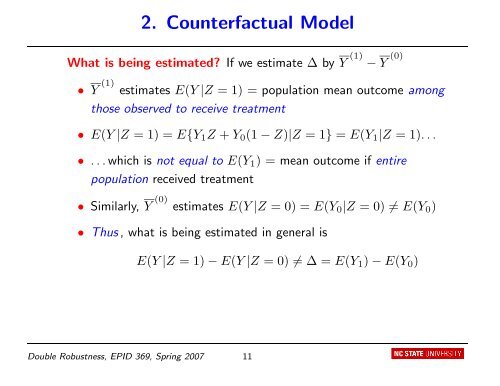Double Robustness in Estimation of Causal Treatment Effects
Double Robustness in Estimation of Causal Treatment Effects
Double Robustness in Estimation of Causal Treatment Effects
Create successful ePaper yourself
Turn your PDF publications into a flip-book with our unique Google optimized e-Paper software.
2. Counterfactual Model<br />
What is be<strong>in</strong>g estimated? If we estimate ∆ by Y (1) − Y (0)<br />
• Y (1) estimates E(Y |Z = 1) = population mean outcome among<br />
those observed to receive treatment<br />
• E(Y |Z = 1) = E{Y1Z + Y0(1 − Z)|Z = 1} = E(Y1|Z = 1). . .<br />
• . . . which is not equal to E(Y1) = mean outcome if entire<br />
population received treatment<br />
• Similarly, Y (0) estimates E(Y |Z = 0) = E(Y0|Z = 0) �= E(Y0)<br />
• Thus , what is be<strong>in</strong>g estimated <strong>in</strong> general is<br />
E(Y |Z = 1) − E(Y |Z = 0) �= ∆ = E(Y1) − E(Y0)<br />
<strong>Double</strong> <strong>Robustness</strong>, EPID 369, Spr<strong>in</strong>g 2007 11
















